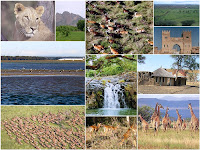Sudan: One of the Greatest Wildlife wonders on Earth
 |
| Sudan Wildlife |
Many, assumed that due to the two Sudan's having long, ongoing conflict and instability - there would hardly be any wild animals of note left. Very few analysts ever thought that there would be such a very large number of animals roaming in the wild - after all the wars, conflicts and famines. It is also known that many tribes in South Sudan eat the meat of wild animals, especially of antelopes; and including that of elephants and buffaloes. Very surprisingly, today, even some elephants and buffaloes still exist.
Before the wars and instability that Sudan has known since its 'independence' from the British and then the Egyptians, the country.......had a fascinating, abundant and a variety of wildlife. Today, some wonderful wildlife still exist. In North Sudan, there are a number of wildlife reserves; most important of all, are two of the most exotic and least visited wildlife parks in the world - the Dinder National Park in the east, close to the Ethiopian border, and Radom National Park, in the south-west. On the Red Sea, are some of the most unspoilt and most pristine coral reefs in the world; one of which and the most notable is the very little visited Sanganeb.
 |
| Sudan Wildlife - Google Map |
In the North of the country, is the Zefah Game Reserve which lies in one of the largest wetlands in the world: the Sudd - also called the Bahr el Jebel, As Sudd or Al Sudd; the effective habitat block of the Sudd swamp is at least 30,000 km. sq. and the peripheral effects of the swamp are believed to extend over the entire 154,325- km, sq. ecoregion. The Sudd is a Ramsar Site and stretches from north of Bor all the way to the North-South Sudan border. This green area of wetlands, includes Lake No - located just north of the vast swamp of the Sudd, at the confluence of the Bahr al Jabal and Bahr el Ghazal rivers. Lake No marks the transition between the Bahr al Jabal and White Nile proper. The Sudd provides watering and feeding grounds for populations of migratory mammals and birds. This floodplain borders the arid Sahelian region and is thus an important watering hole for many species as they move across the landscape.
The Sudd is thick with reeds, grasses, water hyacinth, and other water loving plants. These can form massive blocks of vegetation that can shift position and block navigable channels creating an ever-changing network of water. In addition to the abundant plant life, there are a wide variety of animals that live in the marsh including many types of birds, fish, hippos, and of course mosquitoes which thrive in the warm, saturated air.....Read more here.
In the South-West, is the Southern National Park which is about 23,000 km. sq. Further south, on the border with Uganda is the Kidepo National Park - which South Sudan shares with Uganda; in the south too, also on the border with Uganda, there is the much smaller park - Nimule. Bandingilo National Park (Badigilo) is almost in the middle of the other South Sudan parks; it is very close to Boma and Kidepo; the great animal migration that takes place in and around Boma, involves Bandingilo too. Other parks, are the smaller: Shambe Nature Reserve, within the Sudd - where a variety of birds are in abundance; and the Ashana Game Reseve, within the Savanna woodland - it too, has a variety of birds, and other animals like elephants and giant elands.
Today, the greatest threat and danger both Sudan's wildlife and their habitats face, are from development; especially that of oil exploration and farming. In the North, mechanized farming and the oil industry, has done a lot of damage to wildlife reserves. While in the South, it is oil exploration companies that are devastating wildlife and their Eco-systems; fights between different Southern tribes, in and around wildlife reserves has only made it worst. The continuing conflict between the North and the South and instability in both, only compounds the problem. In both the Sudan's, for the wildlife to thrive and for both the two countries to benefit from their abundant and wonderful wildlife, Sudan needs to have peace, security and stability.
+ The New York Times Slide Show
+ ABC News Slide Show
+ World Wildlife
+ UNEP
+Wikitravel Sudan: North, South
+ World Travel Guide: North, South
+ Lonely Planet: North, South
+ TripAdvisor: North, South


